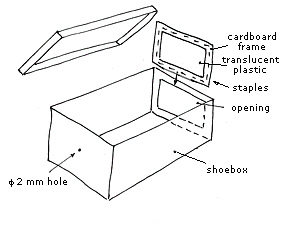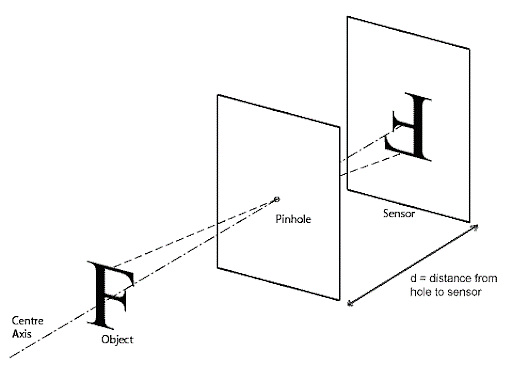A pinhole camera is a rudimentary camera without a lens but with a small aperture (thus the name)—basically a light-proof box with something like a small hole in one side. The camera obscura effect occurs when light from a scene travels through the aperture and projects an inverted picture on the box’s opposite side. The distance between the item and the pinhole determines the size of the pictures.
Pinhole camera
A pinhole camera is the most basic sort of camera available, as it does not have a lens. Mobile phones, tablets, computers, satellites launched into space, and other devices all include cameras. We are all equipped with cameras in today’s environment, and we employ them on a daily basis. In reality, the human eye works similarly to a camera. One feature that all of these cameras have in common is their lenses. The lens of a camera facilitates picture generation, since we can still take a picture without it. A pinhole camera is the most basic camera type that does not have a lens. To create a clear image, it basically uses a small opening (the size of a pinhole) to concentrate all light rays into the smallest possible region. The image produced by a pinhole camera is always reversed. The pinhole camera’s operating concept, construction, and applications will all be discussed in this article.
A pinhole camera is a light-proof box with only a tiny hole in one side that has a small aperture but no lens. If light from an item passes through the aperture, it creates an inverted image on the other side of the box, that is known as the camera obscura effect.
A pinhole camera is made using the camera obscura concept. It is a box-shaped device with a small aperture on one side that lets light in and projects it on the other. The image of an object outside of the box is produced inside the box upside-down using this method.
Working Principle of Pinhole Camera
As light travels in a straight path, pinhole cameras are based on the concept of rectilinear mobility. As light travels in a straight line, a pinhole camera provides an inverted image.
By using the correct proportions of a pinhole camera and the size of a tiny hole by which light enters, we may take an image of same quality like a digital SLR camera. Pinhole cameras are distinguished from other types of cameras by their lack of a lens.
Construction of Pinhole Camera
Depending on how the photographer intends to use it, he can make a one-of-a-kind pinhole camera. The basic design of a photographic pinhole camera is a light-tight box with something like a pin-sized hole over one end and a piece of film or photographic paper wedged or taped on the other. A cardboard flap and a tape hinge can be used to create a shutter. In tin foil, thin aluminium, or brass sheet, a sewing needle is used to punch or drill a pinhole.

Image Formation of a Pinhole Camera
Assume being trapped inside a dark room with no light. A pinhole camera works in this manner. Consider someone cutting a tiny hole in the wall and you are standing against it. If someone held a torch light from the outside, the light might seep into your chamber. When the person holding the torch walked around the light source, the light seeped in, changing in direction and intensity. Rather than a room, imagine a little box which has been light proofed save for a small pin-sized aperture. There’s a film within you which traps light rays instead of you. Instead of you looking at it, the film inside the box captures the image of light rays impacting the opposite side of the wall. Since the tiny opening limits the quantity of light that can enter, the light must be exposed for a longer period of time.
In a traditional camera, a convex lens admits more light while simultaneously focussing it on a small area. This reduces the amount of time you have to spend in front of the camera.

The visual quality of a pinhole camera degrades whenever the hole is the size of a green gramme. The vision thickens and gets more hazy. If the hole size in a pinhole camera grows larger, more light enters, interrupting the image formation.
Pinhole Camera Uses and Applications
To safely view a solar eclipse, the image captured by a pinhole camera can be displayed on a translucent screen in real time.
Pinhole photography is a popular technique for capturing the sun’s movement over time.
Pinhole cameras are made of materials that are electrically and magnetically insensitive. They are widely employed for surveillance since they are difficult to spot.
They are an ideal choice for scientific photography in schools due to their low cost of manufacture and light weight.
Drilling holes on each side of the camera box and attaching the film in the centre with a cylindrical roll allows a pinhole camera to take 360° photographs.
Conclusion
A pinhole camera is a rudimentary camera without a lens but with a small aperture (thus the name)—basically a light-proof box with something like a small hole in one side. The camera obscura effect occurs when light from a scene travels through the aperture and projects an inverted picture on the box’s opposite side. The distance between the item and the pinhole determines the size of the pictures.
As light travels in a straight path, pinhole cameras are based on the concept of rectilinear mobility. As light travels in a straight line, a pinhole camera provides an inverted image.
 Profile
Profile Settings
Settings Refer your friends
Refer your friends Sign out
Sign out






